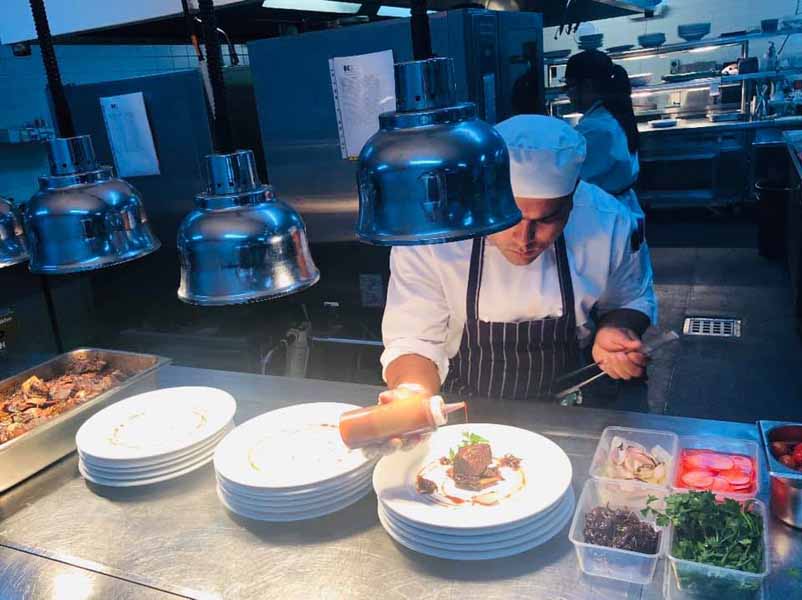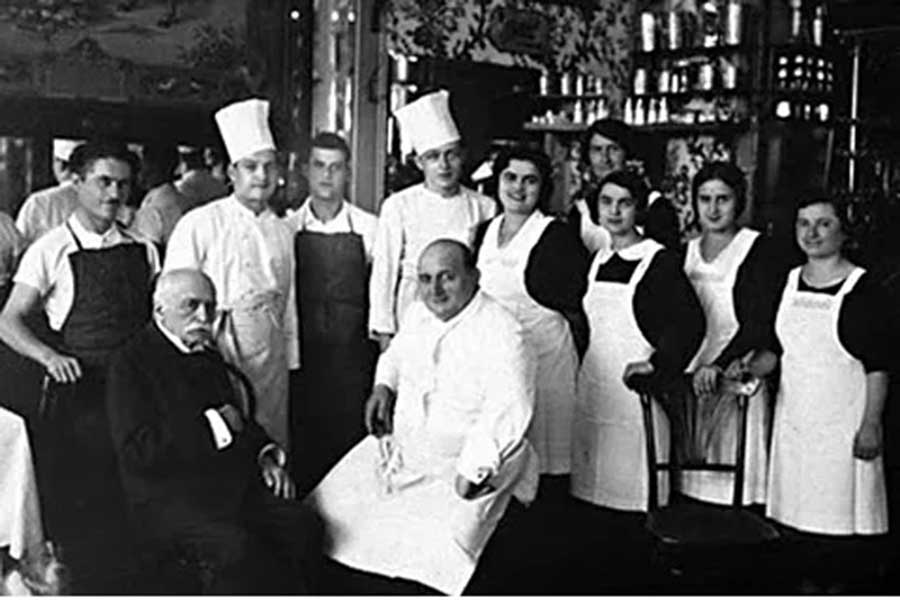Have you ever been enthralled by the culinary masterpieces served at a restaurant and wondered what goes on behind the kitchen doors? Today, we’ll explore the heart of professional kitchens and the kitchen hierarchy, a crucial structure that ensures seamless operations. We’ll also spotlight how CHEFIN, a leading culinary service provider, guarantees exceptional service by partnering exclusively with seasoned chefs.

WHAT’S THE DEAL WITH BRIGADE DE CUISINE?
The kitchen hierarchy, fondly known as the Brigade System (Brigade de Cuisine), was the brainchild of Georges Auguste Escoffier in the late 19th century. He revolutionized kitchen operations by introducing a structured and systematic approach to improving efficiency. Before this, kitchens were often chaotic and disorganized, hindering consistent delivery of high-quality food. Drawing from his military background, Escoffier brought order and streamlined workflow to the kitchen with the brigade system.

This hierarchy is pyramid-shaped, with the executive chef sitting at the top, the head chef, sous chefs, chef de parties, commis chefs, and kitchen assistants at the bottom. Each role has specific responsibilities, ensuring smooth operations.
Within this structure, the commis chef junior is an entry-level position working under the supervision of a chef de partie. This role allows recent culinary graduates or trainees to gain practical experience and learn the operations of specific stations in a professional kitchen.
Chef de Parties, or station chefs, include specialized roles such as the fish chef, responsible for preparing fish dishes; the fry chef, who handles all fried food items; the grill chef, mastering grilling techniques; the pantry chef, preparing cold dishes like salads and pâtés; the pastry chef, an expert in baked goods and desserts; the roast chef, focusing on roasting meats and vegetables; the sauce chef, crafting essential sauces and gravies; and the vegetable chef, preparing vegetables, soups, and starches.
The sous chef de cuisine is the second-in-command in the kitchen, often overlapping responsibilities with the head chef and playing a crucial role in daily operations.
Commis chefs, also known as junior chefs, work under chef de parties to learn specific skills and techniques. They typically recently completed or are still pursuing formal culinary training.
UNDERSTANDING THE BRIGADE SYSTEM
The Brigade System, or Brigade de Cuisine, is a hierarchical structure used in professional kitchens to ensure efficient and organized food preparation and service. Developed by the legendary French chef Georges Auguste Escoffier in the late 19th century, this system is inspired by military organizations. It creates a clear chain of command with distinct roles and responsibilities for each position.
At the top of this hierarchy sits the Executive Chef, who oversees the entire kitchen operation, followed by the Chef de Cuisine or Head Chef, who manages daily activities and brings the Executive Chef’s vision to life. The Sous Chef is the second-in-command, ensuring smooth operations in the Head Chef’s absence. Below them are the Chef de Parties, or station chefs, each responsible for a specific kitchen section, such as the grill, sauté, or pastry. The Commis Chefs (Junior Chef) support them, who are entry-level chefs learning the ropes of various stations.
Understanding the Brigade System is crucial for anyone working in a professional kitchen. It promotes clear communication, reduces confusion, and increases productivity by ensuring every team member knows their role and responsibilities. This structured approach allows kitchen staff to work together more effectively, delivering high-quality food and exceptional service.
THE FIVE CORE POSITIONS IN THE KITCHEN BRIGADE: SOUS CHEF
Executive Chef: The Executive Chef, also known as the Group Chef, is the mainstay of the kitchen and sits at the helm of the culinary pyramid. They strategize, supervise, and oversee all facets of food production.
Head Chef: Also known as the Chef de Cuisine, the Head Chef runs the daily operations. They bring the Executive Chef’s vision to life and craft delicious dishes.
Sous Chef: The sous chef plays second fiddle and directly supports the head chef. They manage the kitchen when the head chef is absent.
Chef de Partie: This chef, also known as a station chef or line cook, oversees a specific production area. There are specialized roles such as fish chef, fry chef, grill chef, pastry chef, roast chef, sauce chef, sauté chef, and vegetable chef.
Commis Chef: This is an entry-level role in which chefs learn the ropes of different stations and embark on their culinary careers.
Here’s a Kitchen Brigade Chart from Fine Dining Lovers that breaks down all positions.

WHY IS THE KITCHEN HIERARCHY SO CRUCIAL FOR A COMMIS CHEF?
The kitchen hierarchy is the backbone of a well-functioning kitchen, ensuring order and efficiency. It facilitates clear communication and assigns responsibilities, preventing chaos during service hours. Moreover, it offers chefs a structured career path, fostering growth and skill enhancement.
IMPLEMENTING THE BRIGADE SYSTEM
Implementing the Brigade System in a professional kitchen requires careful planning and execution. Here are some essential steps to follow:
- Define the Kitchen Hierarchy: Establish a clear chain of command, outlining each position from the Executive Chef to the Commis Chef. Ensure that every role is well-defined and understood by all staff members.
- Assign Tasks and Responsibilities: Delineate the tasks and responsibilities associated with each position. This helps prevent overlap and ensures that each team member knows their duties.
- Establish Communication Protocols: Develop clear communication protocols to facilitate effective information sharing among staff members. These protocols can include regular briefings, checklists, and communication tools.
- Train Staff: Provide comprehensive training to ensure that all staff members understand the Brigade System and their roles within it. This includes both initial training and ongoing professional development.
- Monitor and Adjust: Continuously monitor the effectiveness of the Brigade System. Gather feedback from staff, observe kitchen operations, and make adjustments as needed to improve efficiency and productivity.
Implementing the Brigade System can bring numerous benefits, including improved communication, increased productivity, and enhanced food quality. However, careful planning and execution are required to ensure the system is effective and efficient.

Fine Dining with A Personal Chef
BENEFITS AND CHALLENGES
The Brigade System offers numerous benefits that can transform the dynamics of a professional kitchen:
- Improved Communication: The Brigade System promotes clear communication channels, reducing confusion and ensuring everyone is on the same page.
- Increased Productivity: The structured approach helps streamline workflow, allowing the kitchen to operate more efficiently and effectively.
- Enhanced Food Quality: By allowing each chef to focus on their specific tasks, the system ensures that food is prepared and presented to the highest standards.
- Career Development: The Brigade System provides a clear career path for kitchen staff, offering opportunities for advancement and professional growth.
However, the Brigade System also presents some challenges:
- Complexity: Implementing the system can be complex, particularly in smaller kitchens with limited resources and staff.
- Rigid Hierarchy: The system’s rigid structure can sometimes be inflexible, making it challenging to adapt to changing circumstances or innovative approaches.
- Training and Support: Significant training and support are required to ensure that all staff members understand their roles and responsibilities within the system.
- Communication Breakdowns: Despite its emphasis on communication, the system can still be vulnerable to breakdowns, especially if staff members are unclear about their roles or lack effective communication protocols.
The Brigade System is an effective management tool for professional kitchens; however, it needs careful planning, execution, and continuous monitoring to be truly effective. Kitchen teams can fully leverage this renowned organizational framework by recognizing and tackling its advantages and obstacles.
WHO IS A CHEF DE CUISINE?
Within the kitchen hierarchy, a senior chef typically refers to roles equal to or higher than the Chef de partie level, such as the Sous Chef and Head Chef.
A Chef de partie manages a specific kitchen section, such as grill, sauté, or pastry. They supervise junior chefs and kitchen assistants within their section and play a pivotal role in upholding food quality standards.
The Sous Chef, the right-hand man of the Head Chef, often oversees kitchen operations in their absence. They have a thorough understanding of every station in the kitchen and can step in when needed.
The Head Chef or Executive Chef supervises the entire kitchen operation, from menu creation to upholding food hygiene standards. They lead the team and make critical decisions.
At CHEFIN, we recognize the significant role of experience and expertise in creating unforgettable culinary experiences. We collaborate exclusively with senior chefs at the Chef de Partie level or above. Our chefs boast extensive culinary knowledge and refined skills honed over years of professional kitchen experience.
When you choose CHEFIN, you’re not just hiring a caterer; you’re enlisting a culinary maestro to craft a memorable dining experience for you and your guests.

Remember that every delectable dish you enjoy results from a group of devoted professionals laboring relentlessly to make your dining experience utterly perfect. The next time you settle down for a meal, take a moment to appreciate the well-orchestrated whirlwind that constitutes the kitchen brigade.
